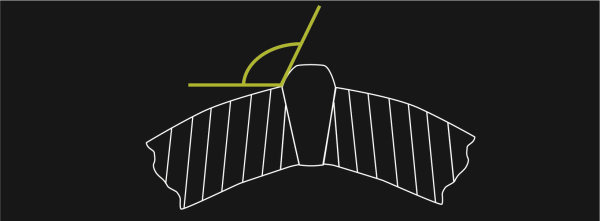Recent advancements in machine vision technology have made a new type of inspection, capable of finding defects related to the forming and welding area of a tube or pipe. The result is improved quality assurance and process control on the production line. The new inspection device is a laser-based triangulation system that measures the outside contour of a tube or pipe in the vicinity of its weld.
Typically NDT (non-destructive testing) systems are placed at the end of a production as a final check. However, the laser inspection system can be placed directly after the weld box. This system can let operators know what is changing in their welding process, allowing them to perform corrective action before significant scrap occurs. This capacity is especially helpful for a closely monitored measurement on ERW/HFI production mills: the Toe Angle.
The Bead Slop Angle
The Left and Right Bead Slope Angles are measured in degrees at either edge of the weld bead, and represent the angle subtended by a line that follows the contour of the weld bead on either side and a horizontal line. Also referred to as the Toe Angle, it can indicate the strength of the weld, and the correct forming of the parent material during the creation of the weld, particularly on an ERW/HF process. A forming problem could be detected because of a larger or smaller than normal slope angle. It is important to measure both the left and right slope angles separately. This is because the forming of the parent material could be asymmetric on a pipe mill, causing the slope angles to be different on either side of the weld bead, and thereby indicating a forming problem.
 The Bead Slope Angle or Toe Angle, measured in degrees from the horizontal.
The Bead Slope Angle or Toe Angle, measured in degrees from the horizontal.
How the WI-2000 System Measures the Bead Slope, or Toe Angle
Xiris Automation Inc. has developed a non-destructive inspection system called the WI-2000 Weld Inspection System. The WI-2000 includes a laser line, and a camera with an optical axis that is offset to the axis of the laser line by an “offset angle”. The WI-2000 creates a visible cross-section of the tube by projecting the laser line on to the tube, and capturing an image of the line using the camera. The resulting image shows a profile of the tube surface as if it were cut in cross section. If a tube is the ideal round, the laser image will represent a section of an ellipse and any anomaly such as the bead can be mathematically detected and the bead slope, measured.
The WI-2000 bases all of its measurements on the differences between the actual laser profile line (seen by the camera), and the ideal mathematical profile based on the tube parameters. By knowing the position of the actual laser profile, the ideal profile, and the size of the pixels in the image, the WI-2000 can detect weld bead profile defects that often escape detection by other quality tools such as Eddy Current testing, or Ultrasonic Testing techniques.
Conclusion
Overall, laser-based 3D imaging systems, such as the WI-2000 from Xiris, offer an excellent measurement option for tube mill owners/operators who want additional, real-time monitoring of weld features. They can be used in a proactive manner, warning operators what is changing in their welding process so that they can perform corrective action before significant scrap occurs. Laser-based 3D imaging systems can operate on any type of material, regardless of its reflectance or magnetic properties, using a single head to perform the measurement.
To learn more about Xiris weld inspections systems, request a consultation with one of our experts.
Stay up to date by following us on social media or subscribe to our blog!



.png)


